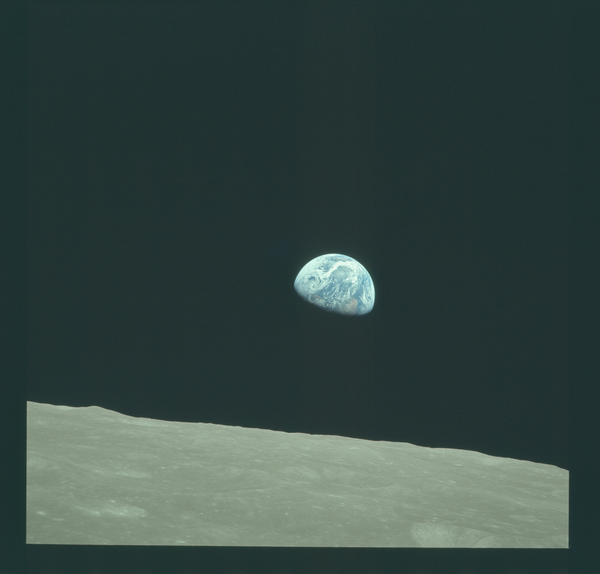At first Bill Anders thought it was no big deal. He and his Apollo 8 crewmates, Frank Borman and Jim Lovell, were on their fourth orbit of the moon, passing over the far side, farther from home than any human beings had ever been, when they happened to see the Earth beginning to peek out over the lunar horizon. It was December 24, 1968.
“Oh, my God, look at that picture over there! There's the Earth coming up. Wow, is that pretty!” said Anders, the crew’s lead photographer. He fired off a single frame in black and white while Lovell found him some color film. He took a few more shots, then went back to business. Of the 865 still pictures the astronauts took, only 14 show the Earth with the lunar horizon in the foreground.
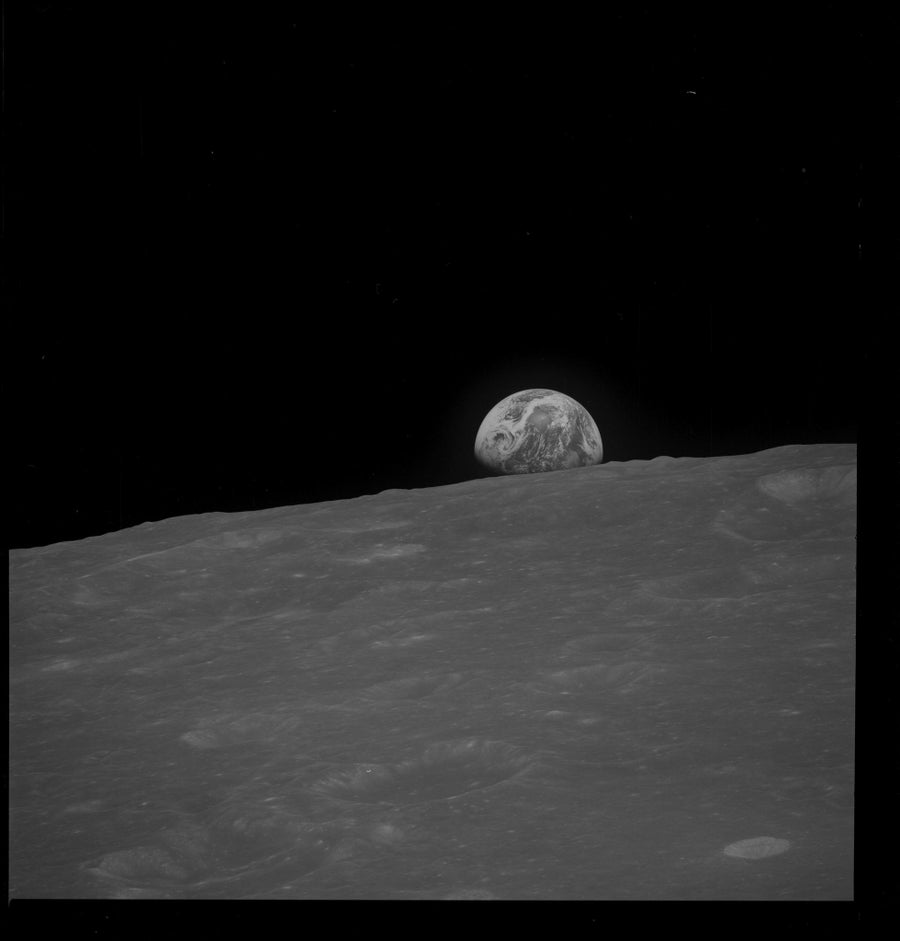
William A. Anders shot one black-and white photo shot of the Earth a moment before the famous color picture. He and his crewmates, Frank F. Borman II and James A. Lovell Jr., had not been able to see the Earth from lunar orbit before this moment, and had made no plans to photograph it. Anders took this picture while Lovell found him a magazine of color film. Credit: Project Apollo Archive Flickr
On supporting science journalism
If you're enjoying this article, consider supporting our award-winning journalism by subscribing. By purchasing a subscription you are helping to ensure the future of impactful stories about the discoveries and ideas shaping our world today.
“We had a mission to do, we weren’t sent as poets,” Anders says now. “We’d had no briefing on taking Earth pictures. It wasn’t a big emotional event. It really wasn’t a big thing.”
But one of those shots came to be known as “Earthrise,” and on any list of the most important photographs of all time, it almost always ranks near the top. For all the risk and effort involved, all the money America spent, all the symbolism about attaining the impossible, the sight of the tiny blue Earth from deep space is probably the Apollo program’s greatest gift to us. In retrospect, that first sighting by the crew of Apollo 8 has eclipsed all that came after—even (I invite disagreement) the landing of Apollo 11 on the lunar surface less than a year later.
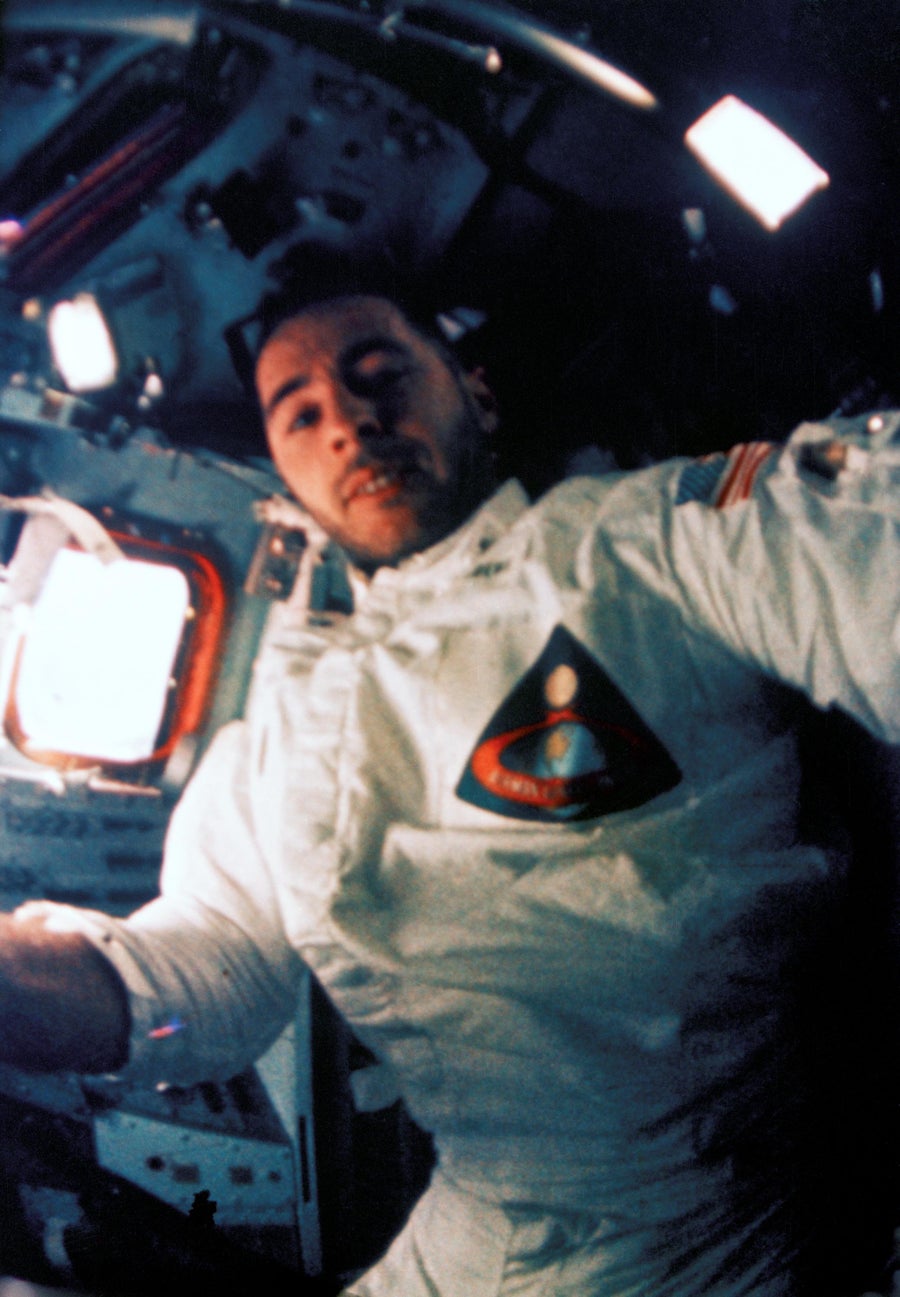
Astronaut Bill Anders during the Apollo 8 flight. This image is from 16mm movie film the crew shot. They did not take any still pictures of each other during the mission. Credit: NASA
There were only nine Apollo flights to circle or land on the moon, and they happened during an all-too-brief period of less than four years. Neil Armstrong’s first lunar footstep was the most-watched moment in the history of exploration, but polls showed that Americans’ enthusiasm for their space program had already peaked with Apollo 8, when Borman, Lovell and Anders read from the book of Genesis as they orbited the moon on Christmas Eve.
“A hundred years from now, when people reflect on our space effort, they won’t bother with Apollo 13, despite the movie and all the hoopla,” Anders says, referring to NASA’s famous near-disaster. “But they’ll certainly remember the first step on the moon, though they may not remember who made it. And the Earthrise picture will go down as the historic image of the time.”
And yet, as its afterglow has faded over the years, a chorus of voices has steadily risen, expressing regret that the Apollo program’s sense of boundless possibility has somehow dissipated. If we could go to the moon in the 1960s, they ask, why don’t we have bases on the moon now? Why, for that matter, haven’t we sent astronauts on to Mars? We have the ability, goes the argument, but we no longer have the will.
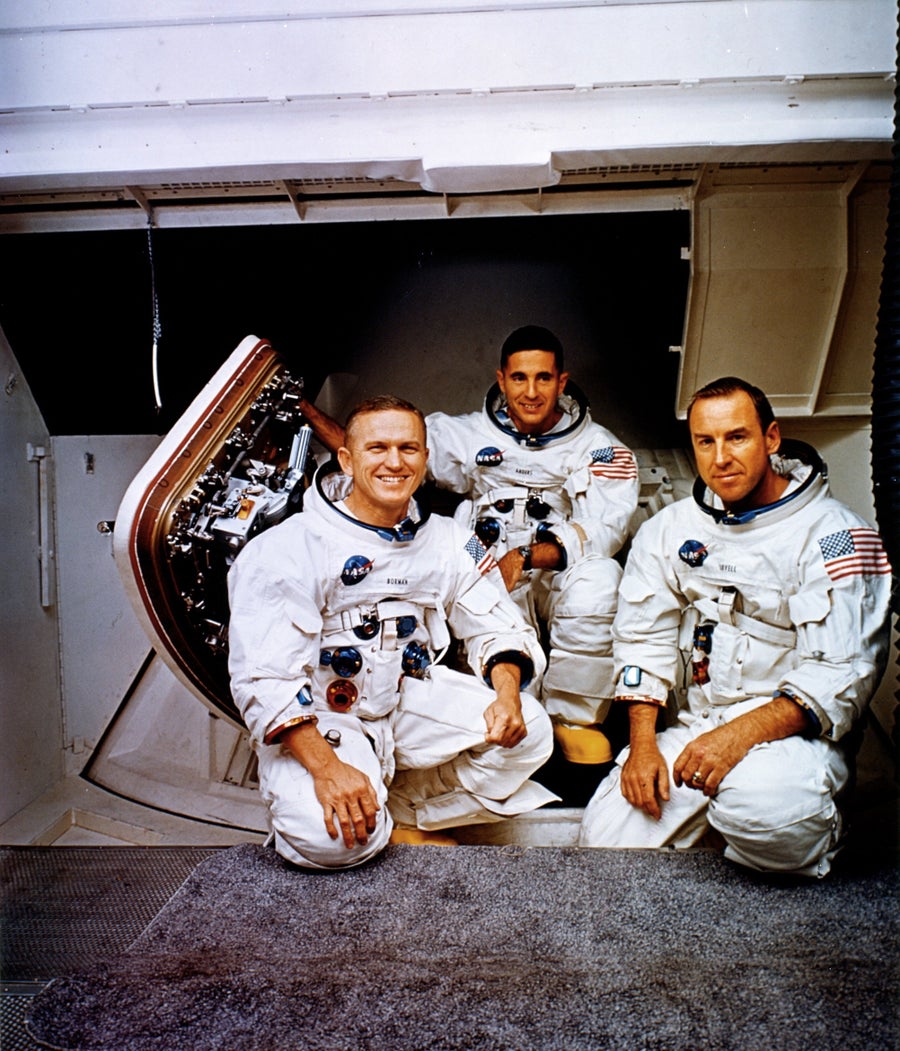
Apollo 8 astronauts Frank Borman, Bill Anders and Jim Lovell (left to right) outside a spacecraft simulator a month before flight. Borman and Lovell, then age 40, had flown in space before. Anders, then 35, was a rookie. Credit: NASA
Except that we no longer have the ability either, at least for now. Historians of science say America got exactly what it paid for from Apollo: a Cold War victory over the Soviet Union, with little capacity to follow up. The Trump White House, like several administrations before it, has plans to send astronauts back to the moon, but even if everything goes right, the plan will take 12 years to do what Apollo accomplished in eight.
In many ways the space race echoed other, earlier competitions. The parallels are far from perfect, but think of Roald Amundsen and Robert Falcon Scott racing to the South Pole in 1911, or Charles Lindbergh’s transatlantic airplane flight in 1927 that won him a $25,000 prize and worldwide fame. (Even Columbus and Magellan were out for profit, trying to find new trade routes for Spain before the Portuguese did.) All of these have gone down in history as voyages of exploration—but in their time they were competitive efforts, with similar results. There was a sprint toward a goal and then, with victory in hand, a retreat. Amundsen did not start a wave of polar settlements; Lindbergh, who had been an airmail pilot, is not the reason for intercontinental airline travel.
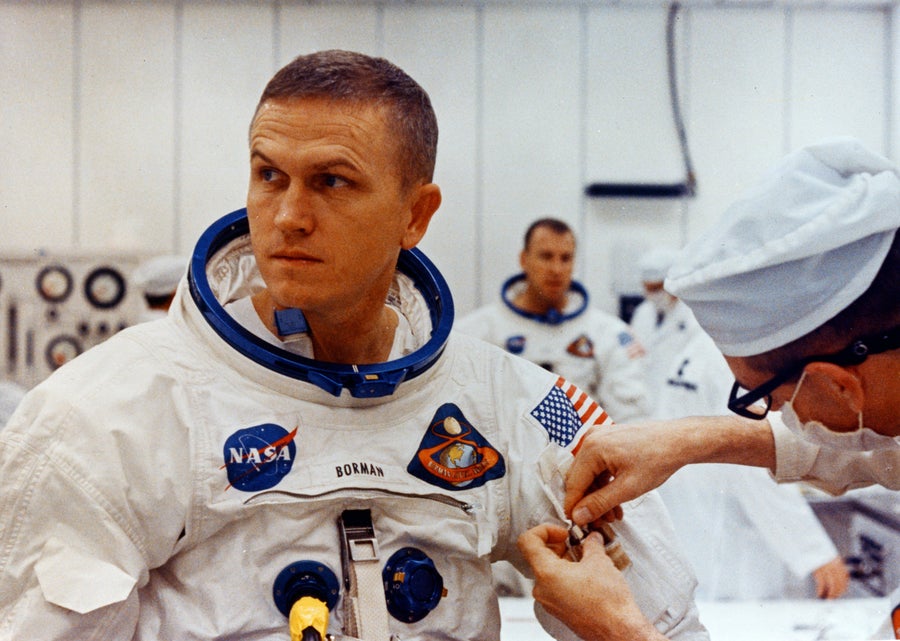
Mission commander Frank Borman suiting up, about four hours before launch on December 21, 1968. Jim Lovell is behind him. Borman later said he was not terribly interested in the idea of exploration; his goal, as an Air Force officer, was to help the United States beat the Soviet Union in the Cold War. Credit: NASA
Exploration can lead to great things—people may even reach the moon—but historians say it rarely happens for its own sake, or as an effort to push back the frontiers of knowledge. The reasons for going tend to be more parochial. Roger Launius, the former NASA and Smithsonian historian, talks of “the four Gs—guns, gold, glory and God”—and Apollo was about glory. That leaves out other important words, such as “sustainability” or “science.”
John F. Kennedy, the martyred U.S. president, is often lionized as the father of America’s lunar triumph (even though Apollo was conceived a year before he took office in 1961, and NASA had plans for a moon landing sometime after 1970). When he spoke about space, his words could soar: “We set sail on this new sea because there is new knowledge to be gained, and new rights to be won, and they must be won and used for the progress of all people,” he said in September 1962.
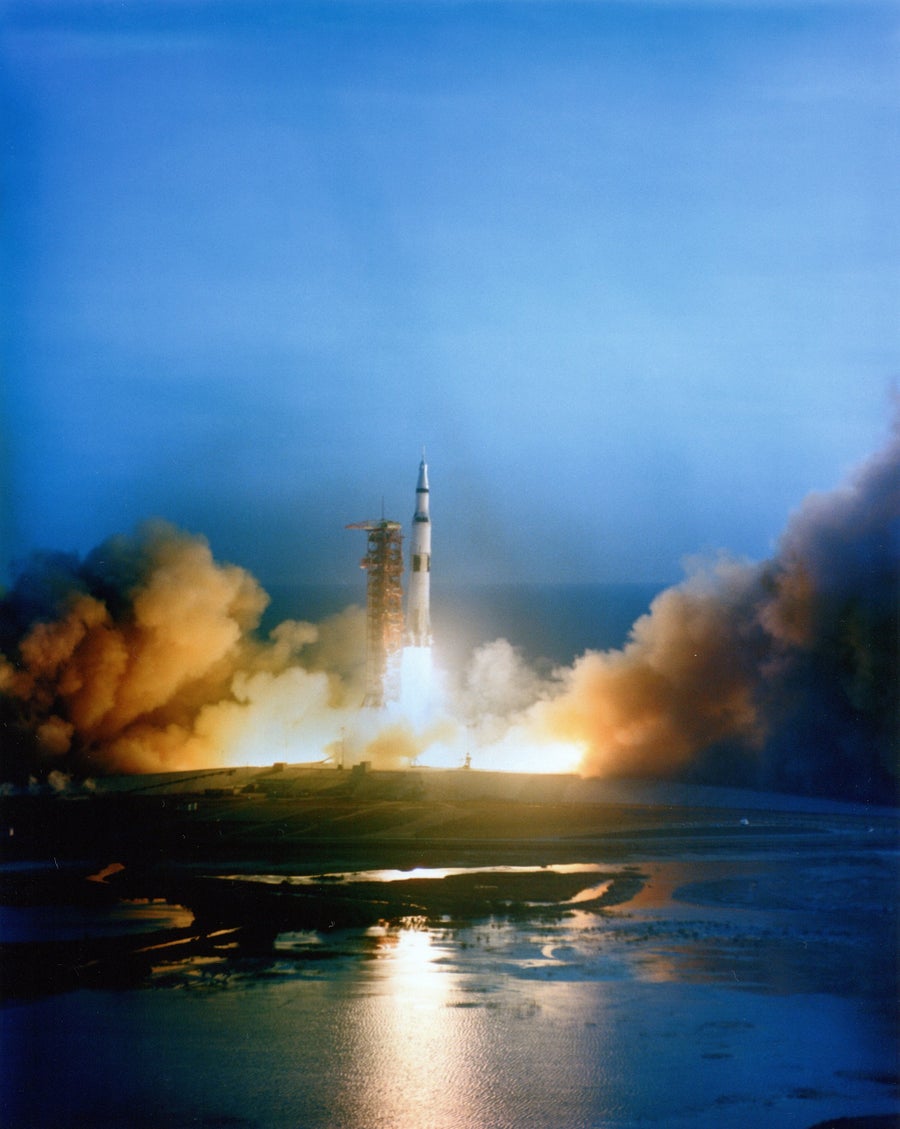
Apollo 8 leaves for the moon, December 21, 1968, 7:51 a.m. The Saturn V rocket, 110 meters (363 feet) tall, generated 34.5 million newtons (7.6 million pounds) of thrust at liftoff. The astronauts later said they were surprised how violently the spacecraft shook as they left the launchpad. Credit: NASA
But two months later, in a closed meeting about NASA funding, Kennedy sounded testy. “Everything that we do ought to really be tied into getting onto the moon ahead of the Russians,” he said when NASA’s then-administrator, James Webb, asked for money to study the environment of space. When Webb pleaded, Kennedy cut him off. “Otherwise we shouldn’t be spending this kind of money, because I’m not that interested in space.”
John F. Kennedy? Not that interested in space? After Yuri Gagarin’s surprise world-first orbital spaceflight from the Soviet Union in 1961, Kennedy made it clear he wanted the U.S. to be first at something in space, and it didn’t terribly matter what the something was. John Logsdon, now a professor emeritus of space policy at George Washington University, writes that Kennedy later made overtures to the Soviets for cooperative flights—certainly less expensive than a race—but when they didn’t respond, he instead asked NASA if it could land astronauts on the moon by the end of 1966.
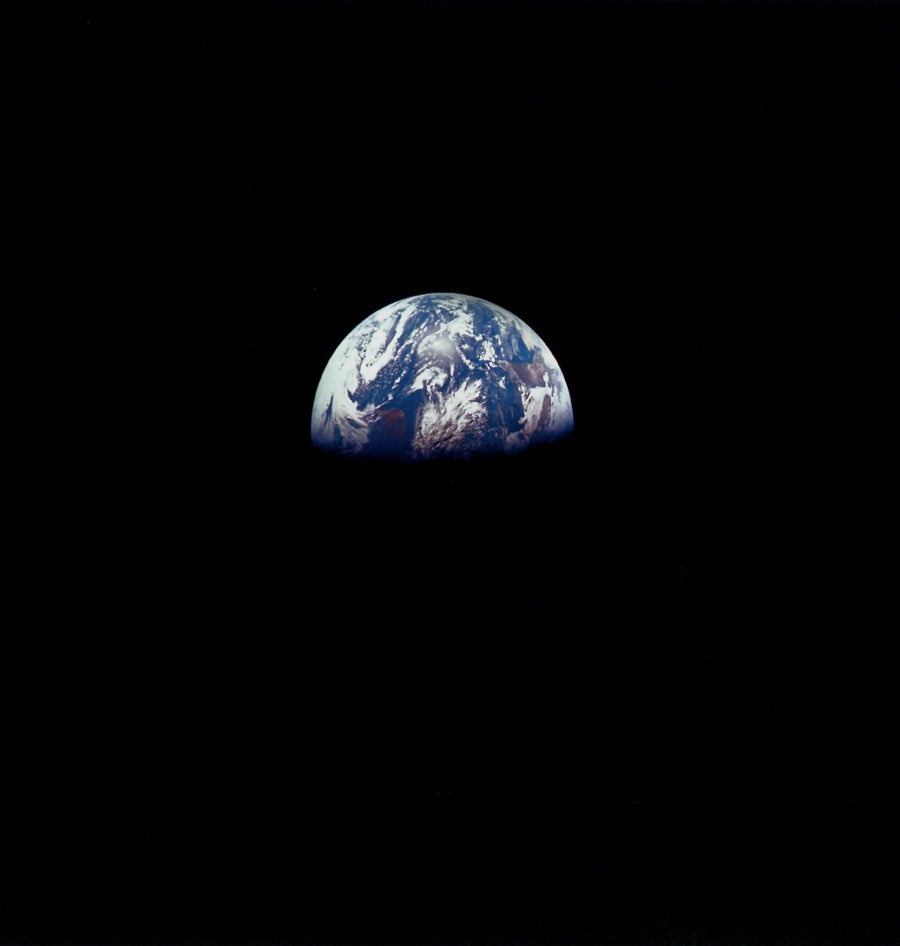
Anders says the view of the shrinking Earth impressed him more than the sight of it from lunar orbit. He took nearly 100 pictures of it as they headed toward the moon, but he and Lovell took only 14 with the moon in the foreground. Credit: NASA
That turned out to be too ambitious, but Kennedy’s challenge—to land astronauts on the moon before the decade was out—pushed existing technology to its limits. The modus operandi of the Apollo flights—sending a command ship with three astronauts to orbit the moon and then landing two of them in a lunar module (LM) —was chosen because it saved weight, fuel and, therefore, development time. The LM was a remarkable piece of technology, in no small part because it was the minimum needed to do the job. Anything expendable, such as seats for the crew, was stripped away. Apollo 8, originally planned as a test of the LM in Earth orbit, became an around-the-moon flight because the LM wasn’t ready—and because intelligence suggested that the Soviets might be about to try a moon flight of their own.
Logsdon wrote in 1970 that Apollo, like the Panama Canal and the Interstate Highway System before it, could be a model for other great governmental ventures in the future. If we could go to the moon, it seemed, we could do anything. But as the years passed, and the moon flights receded into history, Logsdon changed his mind. Yes, he says, Apollo showed government could do great things under the right conditions. But in hindsight he believes the conditions that led to the moon effort were unique and unlikely to occur ever again.
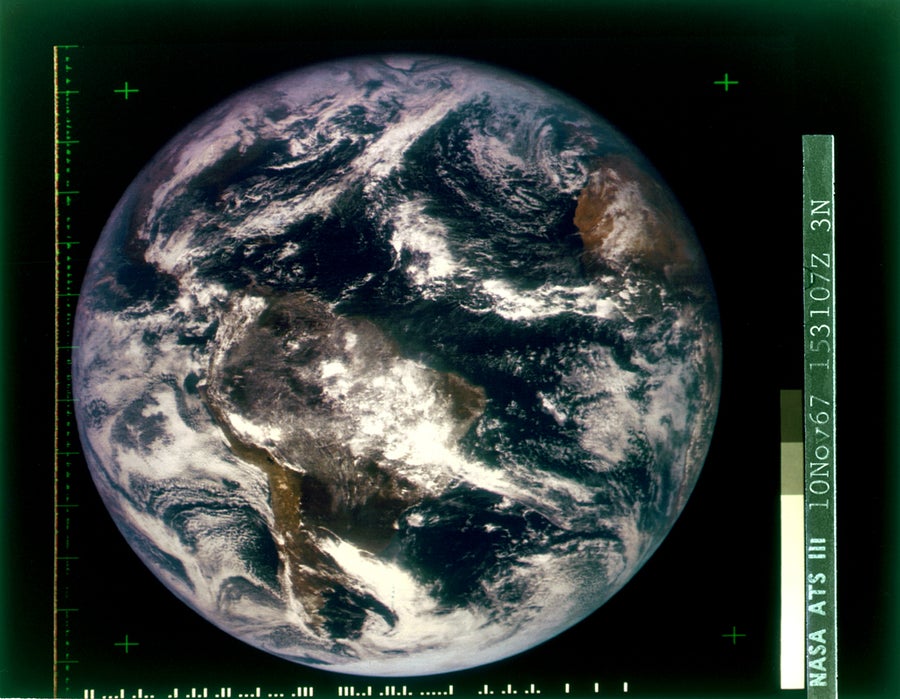
The first color image of the whole Earth was taken by the American ATS-3 satellite on November 10, 1967. South America is at bottom center, seen from a distance of about 35,800 kilometers. The picture got considerable attention at the time, but, perhaps since it was shot by a robotic spacecraft, it made less of an impression than Anders’s “Earthrise.” Credit: NASA
“I do not think there will be another Kennedy moment,” he says. “Certainly not in space and probably not elsewhere.”
The Trump administration’s nascent plans for lunar return are the latest in a long line of as-yet-unsuccessful efforts to prove such thinking wrong. NASA’s current marching orders from the White House call for the space agency to place a space station, called the Gateway, in lunar orbit—a much better starting point, it says, than Earth for constructing settlements on the lunar surface and embarking on missions to Mars. And this time, the plan’s architects insist that the government will not bear the burden alone, instead exploring beyond low-Earth orbit through extensive partnerships with private industry and other cooperative spacefaring nations. This more equitable distribution of labor and responsibility, they say, would advance the national interest by strengthening international relations and bolstering the competitiveness of U.S. science and industry.
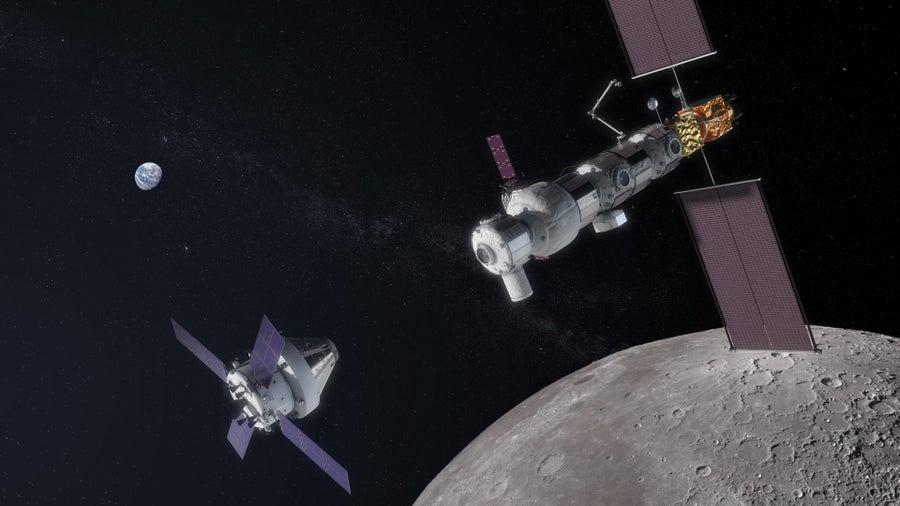
Artist’s conception of NASA’s Gateway station in lunar orbit, with an Orion spacecraft (left) approaching for docking. The Trump administration proposes sending it to the moon in the next decade. Credit: NASA
In other words, the Trump plan fits the mold—all in favor of exploration, but not for its own sake. “Space exploration is not only essential to our character as a nation, but also our economy and our great nation’s security,” Trump said in 2017.
This kind of competition, in a sense, sometimes pushes explorers to do something that isn’t quite yet possible at the time. But when they rush to take those historic first steps, they don’t lay much groundwork for later steps, and they don’t have time to figure out the meaning of what they’ve done. When the goal is narrow—landing a man on the moon and returning him safely to the Earth—the best you can hope for is to achieve it without any surprises. That is what happened with Apollo. It fulfilled Kennedy’s mandate. After that, moon flights went back to being impossible.
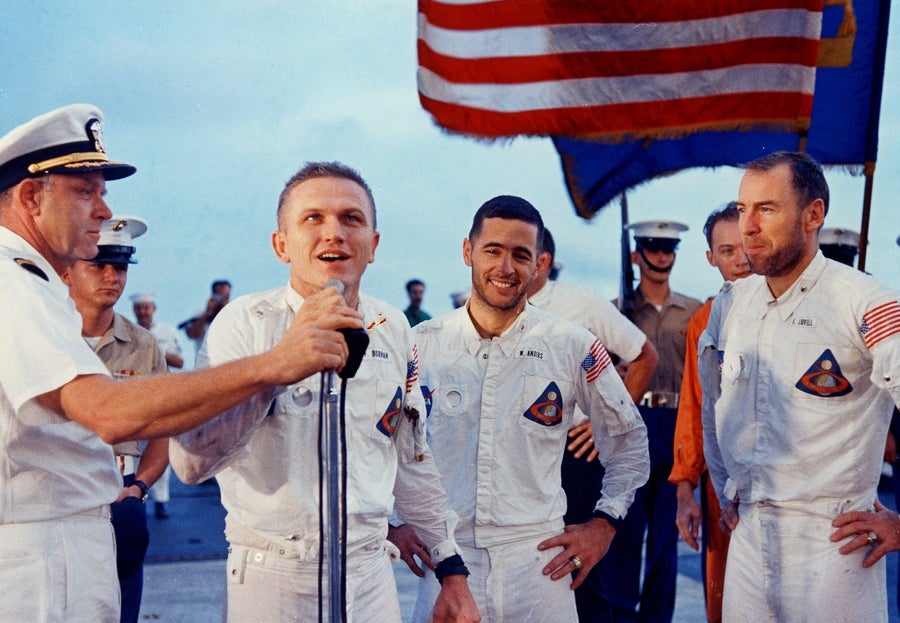
Astronauts Borman, Anders and Lovell (left to right) after splashing down in the Pacific Ocean and being recovered by the aircraft carrier USS Yorktown. They had been in space 6 days, 3 hours and 42 seconds. Borman shaved in the Navy helicopter that picked them up and flew them to the carrier deck. Credit: NASA
But there was one very pleasant surprise, and that was Apollo 8’s view back home. It was one of the few things for which the astronauts had not trained. Today, Bill Anders says that the most striking image to him was not the Earth as seen from the moon, so much as it was the Earth receding in the distance as they left it behind on their outbound voyage. Arguably, that view has changed us—colored our attitude toward the environment, international affairs, our place in the universe—more than Apollo’s other accomplishments.
“It took a while to affect me,” Anders says, “this beautiful blue ball against the darkest black you could imagine, getting smaller and smaller as we went. It made me realize how insignificant our little planet was.”
